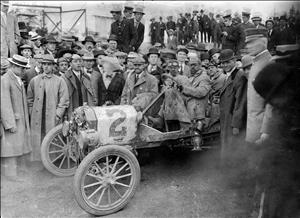On June 23, 1909, a Ford automobile arrives in Seattle from New York City in 23 days flat, completing one of the very early transcontinental automobile races across North America. This Model T Ford arrives first but is later disqualified because the drivers changed the axle during the race. The winner (the second to arrive) is a Shawmut. The race is part of the Alaska-Yukon-Pacific Exposition (A-Y-P).
Initially as many as 35 autos were going to enter the race, but when the race started in New York City on June 1, 1909, at 3:00 p.m., the exact moment that President Taft officially opened the A-Y-P, only six vehicles crossed the start line. They were an Itala, Shawmut, Acme, Stearns, and two Model T Fords.
While crossing Kansas and Wyoming, the contestants had to battle rain and mud, but Snoqualmie Pass was probably the most difficult part of the transcontinental route. The first automobiles had crossed the pass just four years before. Even after King, Kittitas, and Yakima counties had improved the Snoqualmie Pass road for the event, the route over the pass was little more than a wagon road. On the west side of the Cascades in King County, a portion of the road included following the Snoqualmie River bed.
The Last Difficulty
Racers in a Model T Ford that was in third place at the time describes the June 23 descent from the pass as follows:
"We were on the top of the last difficulty. We had pushed through the snow with less trouble than we had expected. We would be in Seattle by four o’clock. When a rock hidden in the mud and snow sprang up to give us one last foul blow. For seven hours we worked on the top of the mountain up among the clouds remedying the trouble that rock had caused. At 5 p.m. [June 23] we were going again. A half mile over the ties of the new "Milwaukee" railroad brought us to the down grade and ninety miles from the finish. The rest was easy" (Prater, 46).
Here is the order of the finish:
- First Place and winner of the cash prize of $2,000 and the Guggenheim Trophy worth $3,500 was the Shawmut, which arrived on June 23. The driver and mechanic were Bert Scott and James Smith.
- Second Place was the Model T that spent seven hours at Snoqualmie Pass, which arrived on June 23.
- Third Place went to the Acme that arrived about June 30.
- The other Model T finished before the Shawmut on June 23, but was disqualified because the axle was changed during the race.
- The Itala arrived in Seattle on a freight car.
- The Stearns never made it past New York state.
The four cars that made it over Snoqualmie Pass were among 105 autos that made it over the pass in 1909. For several years, the pass was one of the great challenges of transcontinental automobile races.
An Earlier Transcontinental Auto Race
An earlier transcontinental auto race was held in 1905 between "Old Scout" and "Old Steady" from New York to Portland, Oregon. The race covered 4,000 miles and took 44 days. "Old Scout," driven by "Huss and Wigle," won the race on June 21, 1905. It ended at the convention of the Good Roads Association being held at the Lewis and Clark Exposition grounds in Portland. The Seattle Times article reporting the race does not mention the make of the automobiles, but the article does open a window on auto driving at the time:
"The race across the continent was a remarkable one. The machines and the drivers endured great hardships, meeting with accidents and obstacles without number. Roads constructed under the direction of engineers were skimmed over at wonderful speed in some sections of the country and in other sections it took entire days to go over a few miles of uncared-for and poorly constructed highways. The delegates to the Good Roads Convention believe that the race between "Old Scout" and "Old Steady" will have great effect in the missionary work necessary to put the roads in all sections of the country in passable condition" ("Old Scout Wins Race Across Continent").

